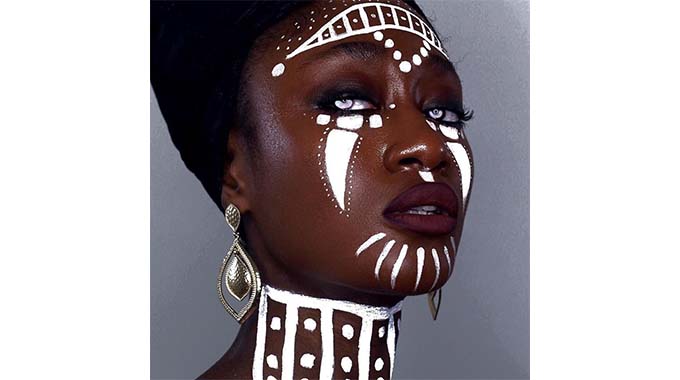Writing Covid-19: Beauty, concealed lips and the coronavirus

Pathisa Nyathi
My most recent book is titled, Bhudaza: My Beautiful Face-Painted Faces of Women from Matobo District. I adjudge the well-illustrated book to be one of my best. It deals with body art as practiced in black Africa and zeroes in on painted faces of women from the northern part of Matobo District.
Bhudaza is a name that we gave to the annual visual art competition where women compete in the art of painting their faces. The pigment used is called isibhuda, hence the name of the competition. The competition falls under “My Beautiful Home-Comba Indlu Ngobuciko” which involves the painting of kitchen huts in the district.
On the day of prize-giving some women participate in Bhudaza where they execute elegant decorative designs on their faces. Prizes are given to those who would have excelled. Prize-giving always takes place at Amagugu International Heritage Centre at Whitewater. Last year, in view of the coronavirus the prize giving ceremony was held at Mthwakazi Business Centre in Ward 25.
The project, strongly supported by Bulawayo’s corporates since inception in 2014, has revitalised the visual art tradition which was on the wane. It was observed that the women who come up with motifs hardly know the meaning behind what they would have painted, both on their hut walls and also on their faces. Bhudaza provides some interpretation of the geometric icons which add to the aesthetics.
I started applying my mind to the interpretation of geometric designs when the African Union was celebrating its diamond jubilee in 2013. It all started with the chevron icon and chevron pattern when I wrote my first book in the series titled, “The Chevron Circle Iconography in African Aesthetics” That was followed by “Echoes From The Past: Interpretation of Zimbabwe’s Decorative Symbols.”
Next in the series was “The Journey to Great Zimbabwe” which was followed by Bhudaza. In all instances I sought to unpack the inspiration and meaning behind the geometric designs. To follow next year will be “Journey to Stonehenge” which bears similar geometric designs. Stonehenge is an iconic World Heritage Site in England. Articles that seek to interpret Stonehenge are on-going in the Sunday News.
In the Bhudaza book I broadly scanned body art as an visual art form practiced in black Africa, from hairdos, scarifications, painting to tattoos.
Various functions of body art are explored and it became patently clear that these were many and varied. In some instances, they expressed the ethnic group to which bearers of the art belonged. In other instances, body art announced the stage of biological development that an individual had attained. Art, regardless of its genre, communicates and does so effortlessly. Art cannot be disregarded if we wish to get some insight into a people’s past, worldview, cosmology, beliefs, perceptions and philosophy. All these reside in and are expressed through artistic renditions.
Seeing as this series of articles deals with Covid-19 and its impact on African cultural practices, we shift the spotlight to focus more specifically on face painting as part of broader body art. The face embraces the face, head, ears and the neck which complement each other to render a beautiful face which is enchanting, charming and enthralling. When part of the face is covered, an important complementary aspect is lost.
I was looking at the exquisite cover of Bhudaza which depicts a lady’s face that is wearing some blue lipstick. It is a loud colour which is toned down by colours of designs on her face and the soft brown colours of her head dress. Equally soft colours of her bead necklace add to the overall ambience that adds to the beauty of her face. Natural beauty is complemented and augmented by cultural interventions that seek to enhance the former.
My mind had been toying around with the idea of writing about the wearing of lipstick and relating it to the Covid-19 pandemic where the mouth is covered up by the face mask. Perhaps I was under an illusion that the wearing of lipstick would decline when lips are no longer exposed for all and sundry to gaze and indulge in their beauty. Face mask or no face mask, lips are still given a shade of lipstick.
The colour of the lipstick varies depending on the prevailing mood. When one goes to attend a funeral where the colours of mourning are dark and uninspiring, the colour of the lipstick must reflect that mood. On the other hand, when the function being attended is jovial and happy, the lipstick should match the mood. In fact, the mood is expressed by the entire face, not just the lips alone.
This I was told by a lady in a leading pharmacy along Robert Mugabe Way in Bulawayo. She was convincingly knowledgeable in matters of beauty and aesthetics. “When a lady takes a bath, that alone is not enough. She must proceed to wear some perfume,” she said as she entered the price of some medication in a machine. For a moment my mind was taken back to the old days when Ndebele women used to apply some talc on their bodies to repel repulsive odours, uhlofu. The women knew which plants had a pleasant aroma: umguza, inkiza, ubande and imadlana.
The essence of what she was telling me was that lipstick is applied by ladies as part of dress. It is just like carrying clutch bags or handbags even when these are practically empty but full of completed etiquette. Once tradition has been established, then it is adhered to without question. Surely, learning does not end. Even after death the departing spirit must learn where to go, how to get there and become part of the community of related spirits.
Colours have a language that expresses a lot of things: mood, tone, style and taste.
That colour is sometimes expressed within the context of certain decorative designs that have a language of their own. In the main, the designs are expressions of beauty and thus favourably dispose a wearer to positive and favourable consideration. The wearer of beauty is a charmer. Such a face disarms even the most hard-hearted.
Decorated faces are presented during ceremonies such as weddings and similar public functions. The ladies, more than gentlemen, seek to be very presentable. It’s not unique to them. It is a phenomenon that is present in other animal, bird, insect, reptile and snake species. It seems to be an innate trait.
Beauty is always for a purpose, calculated visual consumption and a lot more. Where the face has to be covered to curtail the spread of the Covid-19, that natural instinct fails to find expression. Beauty is not holistically presented.
Public gatherings lack the glitter, sparkle, dazzle and glamour that would otherwise have attended the function. This then takes us to annual ritual festivals that have been negatively impacted upon by measures instituted to curtail the spread of coronavirus which loves to locate itself within the human respiratory system.
Next time we shall look at how such ceremony in Zambia has been negatively impacted upon by Covid-19.










Comments